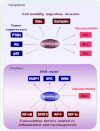Janus-faced role of SIRT1 in tumorigenesis
- PMID: 23050959
- PMCID: PMC3499659
- DOI: 10.1111/j.1749-6632.2012.06762.x
Janus-faced role of SIRT1 in tumorigenesis
Abstract
Silent mating type information regulation 1 (Sirtuin 1; SIRT1) has been reported to regulate various physiological events, such as aging and metabolism, via deacetylation of histone and nonhistone proteins. Notably, cumulative evidence supports the notion that SIRT1 has a Janus-faced role in tumorigenesis. SIRT1 contributes to anti-inflammation, genomic stability, and cancer cell death, and hence it has tumor-suppressor properties. On the other hand, SIRT1 can stimulate oncogenic signaling pathways and can create a tumor microenvironment favorable to growth and survival of cancer cells. Such dual functions of SIRT1 may be determined, at least in part, by its subcellular localization. Interestingly, SIRT1 displays differential localization in normal cells and cancer cells, which in turn may affect the substrate specificity for its deacetylase activity.
© 2012 New York Academy of Sciences.
Figures



References
-
- Guarente L. Franklin H. Epstein Lecture: sirtuins, aging, and medicine. N. Engl. J. Med. 2011;364:2235–2244. - PubMed
-
- Cohen HY, et al. Calorie restriction promotes mammalian cell survival by inducing the SIRT1 deacetylase. Science. 2004;305:390–392. - PubMed
-
- Borra MT, Smith BC, Denu JM. Mechanism of human SIRT1 activation by resveratrol. J. Biol. Chem. 2005;280:17187–17195. - PubMed
Publication types
MeSH terms
Substances
LinkOut - more resources
Full Text Sources

